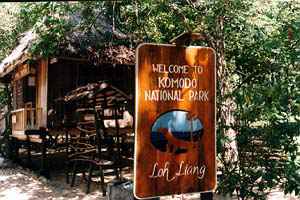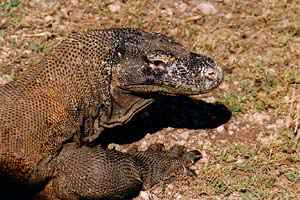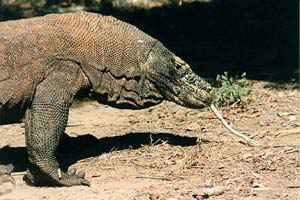Special Feature: Products Sally Recommends
In Search of a Real-Life Dinosaur: Part 3

Komodo is not a place where people come to stay in comfort. There is only one village, and it has no tourist accommodation. Visitors can stay at the National Park which has very limited and basic accommodation on both Komodo and the adjoining island of Rinca. Komodo villagers make their livelihood fishing for squid. At one stage they were paid by the government to raise goats and deer to be fed to the dragons by the rangers. But it was then noticed that the easy life of being fed for tourist-viewing made the dragons so lazy that they would not hunt, so the feeding habit has been recently abandoned and the dragons are again hunters.
Tales abound about their poisonous bite. That's not quite true, though for all intents and purposes it might be. The dragon's gastric juices are so powerfully corrosive that they will dissolve animal bones and even antlers and hooves. And their saliva is so full of bacteria that once bitten, any animal will certainly die of the resulting infections.
The Komodo Dragon, called Ora by the locals, has the technical mouthful of Varanus Komodensis, and is a direct cousin of the dinosaur and the largest of the world's lizards. It looks exactly like some of the reconstructed dinosaurs one sees in museums of natural history -- the size of a large crocodile with a head-shape of a lizard, for that's the family these animals belong to. This one had a fairly distended stomach proof of the fact that it had eaten fairly recently.

Dragons have hinged jaws that act similarly to those of a snake. Even if they catch a largish animal like a young wild boar they may unhinge their jaws and swallow it whole.
Our ranger guide took us to the area where the Dragons had, for some considerable time, been regularly fed. A few of the older ones still lurked in the area, we had been told, and soon this was proved to be accurate. In the shade of a tree three of these prehistoric creatures were taking a rest. We approached the one that was nearest, a full-grown monster well over ten feet long.
Its legs were in an ungainly position that, to the uninitiated, seemed as if the palms of his paws were facing upwards. These showed the huge claws that make such a formidable weapon during attack. But if the Dragon looked relaxed, its beady eyes, following every move we were making, were a clear giveaway that we should be on maximum alert. Just then a small group of German tourists arrived, talking loudly and totally ignoring the fact that these animals might have been dangerous. Our guide commented on this, saying that Oras were quite unlikely to attack people -- or anything else -- just after they had gorged themselves. But one should never ignore an Ora, for to do so was a health-hazard. In order to make the five thousand or so visitors that make it to the National Park each year feel secure, the government refrained from making it known that Oras had killed humans too. Our ranger, for one, wasn't going to take any silly risks!
 But these three were determined not to be photographed in any "action" shots. Even when another ranger prodded one with a long forked branch, it would not move at all. We saw plenty of smaller Komodo Dragons that did move around a lot, but they did not look as impressively sinister as their elders. So this photo-shoot went out with a whimper and we returned to our boat. The next day, at the adjacent island of Rinca, we might have better luck.
But these three were determined not to be photographed in any "action" shots. Even when another ranger prodded one with a long forked branch, it would not move at all. We saw plenty of smaller Komodo Dragons that did move around a lot, but they did not look as impressively sinister as their elders. So this photo-shoot went out with a whimper and we returned to our boat. The next day, at the adjacent island of Rinca, we might have better luck.
The Perintis arrived off the Rinca pier around 8 a.m. the next day and we joined yet another ranger-guide to search for a more active and photogenic Ora. The one we were to find fitted that bill -- perhaps a little too well.
The dragon had been dozing in the sun when I asked if I could see the dragon in action so we could take a few pictures. I got more than I bargained for when our guide threw the creature a fish.
Suddenly the sleepy lizard-like creature metamorphosed into a lightning fast monster from a sci-fi movie, long clawed feet moving across the ground at Olympic record speed. On reaching the fish, it unhinged its jaws to take it whole in one gulp.
With appetite aroused the dragon stood surprisingly high on its legs moving its head from side to side, making a noise like a balloon being deflated.
Eyes glaring, it started to move its long forked yellow tongue in and out of its mouth with mesmerizing speed. It was looking for more food --- and all it could see was us!

Our ranger explained in a low voice keeping a watchful eye on the Ora at all times. "He uses that tongue like a finely-tuned nose. It gives him his sense of smell and it is deadly accurate. He's picked up the scent of the other fish in my bag" he whispered. Mentally wishing that I had a Lear Jet parked nearby I awaited instructions from the ranger. "There's a wooden platform behind us that the dragon cannot climb. Slowly head for that, and the moment I've thrown the second fish, run for it and get up there quickly, I'll be right behind you."
Fortunately, at this time, I did not know that Komodo Dragons are swift and efficient hunters of water buffalo, deer, wild boar and sometimes even horses -- their hinged jaws making it possible to swallow a 60kg boar in one sitting. The gastric juices of the dragon can even handle bones and hooves of deer and buffalo. They can outrun a cheetah during a very short sprint, but over a mile are still faster on their feet than the fastest human. Their small front teeth are expendable, and if they lose them they grow more.
As instructed we headed toward the wooden platform, just daring to watch the moment the Ora pounced on the second fish, enveloping it in its powerful jaws and then began running after us. After its fish course, it wanted meat!
For half an hour the dragon stood beneath us on the platform hissing and exhaling clouds of hot breath, rank enough to scour barnacles off a submarine. Then, it decided to look elsewhere for lunch and lumbered off into the rough forest that circled the clearing. Although we saw many more dragons during our visit to Komodo National Park none were as aggressive as this one, and by then we had become a little wiser and did not make the mistake of arousing their appetites.
Our skipper, Captain Herman Hasle, smiled knowingly when we told of our adventure. "Technically, they are the largest lizard on earth, a giant species of the monitor lizard, directly linked to the dinosaur, and can weigh over 150 kilos. Amazingly, no-one in the outside world knew about these animals until discovered on a field trip in 1911."
These animals lay eggs, but are cannibalistic. So once hatched, the baby Ora climb the first tree they can find, and stay there most of the time, living on insects, birds and anything else they can scavenge. Oras lose their ability to climb trees around the age of six by which time they get too big and clumsy to scamper up tree trunks. But until that time adults can't chase them, and they have no other serious natural enemies."
Herman went on to explain that the Komodo Dragons, being cold-blooded, are fairly sluggish in the early morning and charge up their energy by lying in the sun. And that is precisely what our dragon friend was doing when we found him on this morning. We had been luckier than a Swiss tourist, who in July 1979 was killed by the dragons.
"The Ora were nearly on the way to extinction," Herman commented as we were finishing our dinner. "In the 80's the numbers had decreased to around fifteen to eighteen hundred. The Government thought of making them a tourist attraction, and paid locals to grow goats which were strung up so the dragons could feed on them, and tourist could take the pictures. In a few years, the Ora had almost forgotten how to hunt. International zoologists persuaded the Government to allow the dragons to resume hunting."
The strategy has worked and there are now estimated to be over three thousand Ora on Komodo and about fifteen hundred on neighboring Rinca, and some hundreds on Eastern Flores.
Too soon our fascinating cruise came to an end, and we returned to Bali. For anyone who wants to combine the superb and stylish resorts of Bali with a cruise that is the ultimate in luxury adventuring, a cruise on the Perintis to the habitats of the Komodo Dragons may be just the way to go.
![]()
For details and bookings for the Perintis Island Cruise that will take you to Komodo and other nearby Islands, contact: The Kupu Kupu Barong Resort, Ubud, Bali, Indonesia Fax: ++ 62 361 975 079
Best Time to Go:
November to February is rainy season in this area. We recommend May through to October as being ideal, though rainy season in this part of the tropics usually means only two hours of solid rain, mostly between 4 and 6 p.m.
Take:
A wide brimmed hat, comfortable casual cotton clothing and walking shoes. Buy plenty of duty-free film when departing. Take about twice as much as you think you'll need. This part of the world is tremendously photogenic.
Stay:
When in Bali we recommend three days at Kupu Kupu Barong in Ubud, the inland area where arts like painting, woodcarving, silver-smithing and other classic Balinese crafts thrive. Then enjoy three or four days at one Bali's great beach resorts like The Four Seasons, The Ritz Carlton or the other splendid resorts on the coast.
Getting There:
Singapore Airlines, an Award-winning international carrier, will take you to Bali via Singapore. The cruise prices include transportation from Bali.
![]()
Walter & Cherie Glaser are an international travel-writing team based down under in Melbourne, Australia.
Note: This information was accurate when it was published. Please be sure to confirm all rates and details directly with the businesses in question before making your plans.



